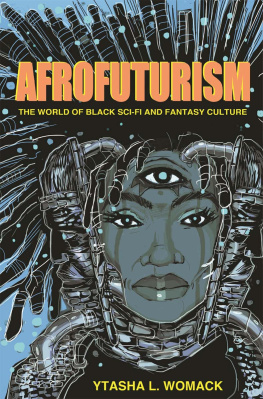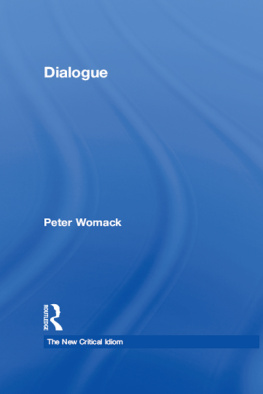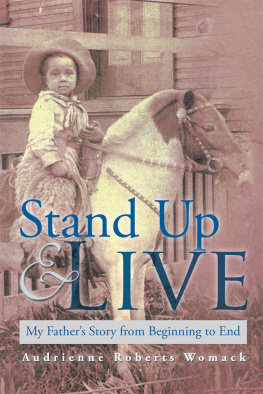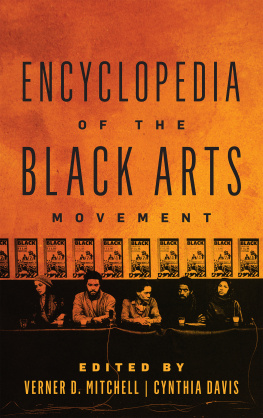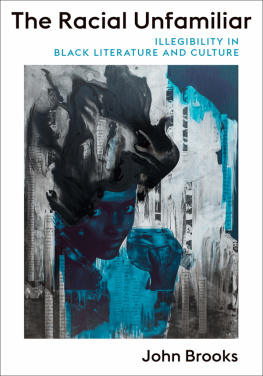

Copyright 2013 by Ytasha L. Womack
All rights reserved
First edition
Published by Lawrence Hill Books, an imprint of
Chicago Review Press, Incorporated
814 North Franklin Street
Chicago, Illinois 60610
ISBN 978-1-61374-796-4
Library of Congress Cataloging-in-Publication Data
Womack, Ytasha.
Afrofuturism : the world of black sci-fi and fantasy culture / Ytasha L. Womack. First edition.
pages cm
Includes bibliographical references and index.
ISBN 978-1-61374-796-4 (trade paper)
1. Science fictionSocial aspects. 2. African AmericansRace identity. 3. Science fiction filmsInfluence. 4. Futurologists. 5. African diaspora Social conditions. I. Title.
PN3433.5.W66 2013
809.38762093529dc23
2013025755
Cover art and design: Ioe Ostara by John Jennings
Cover layout: Jonathan Hahn
Interior design: PerfecType, Nashville, TN
Interior art: John Jennings and James Marshall ()
Printed in the United States of America
5 4 3 2 1
I dedicate this book to Dr. Johnnie Colemon, the first Afrofuturist to inspire my journey. I dedicate this book to the legions of thinkers and futurists who envision a loving world.
CONTENTS
Index
ACKNOWLEDGMENTS
I would like to thank the stellar Lawrence Hill Books team: Cynthia Sherry, Michelle Schoob, Caitlin Eck, Mary Kravenas, and the many others who devoted their time and passion to bringing this book to light. Special thanks to John Jennings for his thoughtful insights and enlightening art. Thanks to John Jennings, Reynaldo Anderson, Shawn Wallace, and Stanford Carpenter for their willingness to throw mental softballs in the game of Afrofuturism mind chatter. I thank the many Afrofuturists, including Alondra Nelson and D. Denenge Akpem, who shared their work and ideas with me. I thank Linda and Leonard Murray, John Martin, Patrick Saingbey Woodtor, and Kerry James Marshall for their support. Thanks to curator Christine Mullen Kreamer for her heartfelt contributions. Thanks to Craig and Cory Stevenson for their artistic contributions. I thank my mom, Yvonne Womack, who willingly embarked on the Afrofuturism journey and gave me my first space suit. I thank my dad, Lloyd Womack, who unknowingly encouraged the cosplay imagination. I truly thank Susan Bradanini Betz, who believed in this project from the start and championed its existence.
INTRODUCTION
W ho are you? the Cheshire cat asked Alice in the mindbending Alice in Wonderland. As a kid, I found the scary disappearing kooky kitten and his prickly questions nightmarish. When I got to the page where those glow-in-the-dark eyes in my Disney-friendly child-version storybook appeared, Id flip the page faster than Gabby Douglas on the balance beam. Frightening, albeit intriguing. When Morpheus gives Neo the red pill/blue pill option, prefacing that he will find out just how deep the rabbit hole goes, The Matrix viewers know this is another tornado ride to Oz. No, Dorothy, youre not in Kansas anymore. And for those who adopt the Afrofuturist paradigm, the ideas can take you light-years away from the place you call home, only to return knowing you had had everything you needed from the start.
Readers, our future is now. Fortunately, there are guideposts on this worded journey through the cosmos, key archetypes that anchor the imagination on this spaceship ride dubbed freedom: the Dogons Sirius star, the fabled mermaid, the sky ark, a DJ scratch that blares like a Miles Davis horn, an ankh, a Yoruba deity, an Egyptian god, a body of water, a dancing robot, an Outkast ATLien. And theres electricity, lots of electricity, nanotechnology, and plants. Someone may shout, Wake up! Others will echo chants of hope. Maybe youll hop into a parallel universe with a past that reads like a fantasy or a future that feels like the past. But no trek is complete until you spot a sundial-sized headdress or that psychedelic wig. We like really big hair or no hair at all. Call it the power of the subconscious or the predominance of soul culture gone cyberpop, but this dance through time travel that Afrofuturists live for is as much about soul retrieval as it is about jettisoning into the far-off future, the uncharted Milky Way, or the depths of the subconscious and imagination.
Sun Ra, George Clinton, and Octavia Butler are sides of that Giza-like pyramid you find. Although the controls on the spaceship match your video game console, your life is not a video game. You are in cyberspace. Satellite maps dont work here. You cannot check in, although you can click like. No hyperlinks. If lost, get down to get up, go up to get down. If you must communicate, invent a communication device with a social media platform, and youll be heard. Take photos, lots and lots of photos. Like every good hero, you have a digital soundtrack. But most important, you have nice reading material to smooth the ride. Oh, and youll need sunglasses, really cool sunglasses.
Stay Spacetastic,
Ytasha
W hen I was in the fourth grade, I was Princess Leia for Halloween. Leia, the princess and born leader of the rebel forces in Star Wars Episode IV: A New Hope, was my heroine in elementary school. It is a distinct memory, because wearing all white with a wooden sword on your hip in a rainstorm and trying to explain that youre a cosmic princess to candy-giving neighbors isnt a memory you forget. With two giant braids twisted into coils and pinned neatly on either side of my head, I found the idea of being a galactic princess with guts and brains to be pretty cool. Later, I would fully understand the myth of the Force and the archetypical battles between ego and light that render Star Wars fans so enthusiastic. But as a kid, I was a bit more infatuated with lightsabers and Ewoks and just glad that Luke and Leia didnt fall in love, because they were Jedi siblings.
While it was fun to be the chick from outer space in my imagination, the quest to see myself or browner people in this space age, galactic epic was important to me. Through the eyes of a child, the absence of such imagery didnt escape me. For one, I secretly wished that Lando Calrissian, played by sex symbol Billy Dee Williams, hadnt lost the Millennium Falcon in a betthen maybe he, and not Han Solo, would have had more screen time navigating the solar systems. I wished that when Darth Vaders face was revealed, it would have been actor James Earl Jones, the real-life voice behind the mask, and not British thespian David Prowse who emerged. Then again, I also wished that Princess Leia and not Luke had been the first sibling trained in the way of the Jedi, and then I could have carried a lightsaber at Halloween instead of my brothers wooden sword.
While it would be easy to dismiss these wishes as childhood folly from yesteryear, its in wishes like theseall a result of the obvious absence of people of color in the fictitious future/past (remember, it was a long time ago in a galaxy far, far away)that seeds were planted in the imaginations of countless black kids who yearned to see themselves in warp-speed spaceships too. With the diversity of the nation and world increasingly standing in stark contrast to the diversity in futuristic works, its no surprise that Afrofuturism emerged.
No surprise either that with Princess Leia a few solar returns behind me, I would create
Next page
